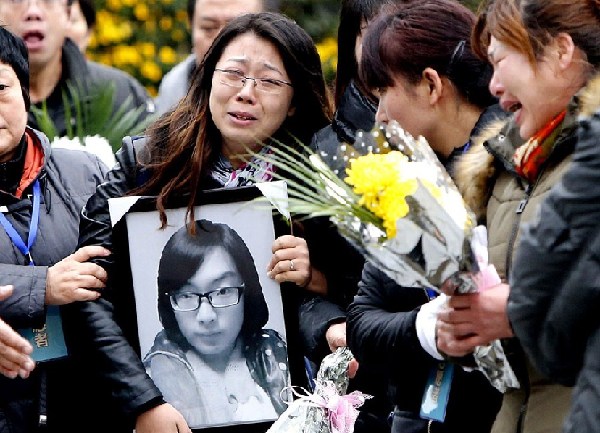Mayor: Shanghai stampede a 'bloody lesson'
Shanghai, January 7, 2015 Adjust font size:
The New Year's Eve stampede on the Bund was a "bloody lesson" for Shanghai, Mayor Yang Xiong told city lawmakers yesterday.
 |
|
Relatives mourn at the site of the New Year's Eve stampede on the Bund yesterday, the seventh day of the tragedy that left 36 people dead, mostly in their early 20s, and another 49 injured. According to traditional beliefs, souls of the deceased revisit families on the seventh day. — Xinhua |
The city must draw a lesson from the tragedy, he told a session of the city's legislature, the Shanghai People's Congress Standing Committee. "The lesson was extremely profound and extremely painful," he said.
Thirty-six people were killed and dozens more were injured after tens of thousands of people gathered on the historic riverfront walk to usher in the New Year.
"Although the cause of the incident is still to be confirmed by investigation ... we must learn from the bloody lesson, as well as deeply reflect on this matter," Yang said.
Medical treatment, handling of the aftermath and a joint investigation were all under way, he said.
He had also ordered an overhaul of emergency plans for handling large crowds at events in the city.
Yang said people should not wait to strengthen security controls, especially in key areas during peak periods.
"We need to conduct a thorough overhaul of the current emergency plan for large crowds, and safety is our bottom line of all works," Yang said.
He ordered strict implementation of preventive measures and emergency plans, and urged the promotion of more public security education.
Authorities in Shanghai have asked all local governmental departments, public institutions and other enterprises to enhance safety management.
All units in the city have been told to check safety measures and enhance security management before the busy Spring Festival holiday.
Shanghai has decided to tighten controls on large gatherings after the stampede, Vice Mayor Zhou Bo told a national conference on workplace safety. Mass activities will face stricter registration procedures, and canceled if they violate safety rules.
Zhou said the city was making changes to emergency procedures and rearranging scheduled gatherings.
Twenty-five of the 36 people killed in the stampede were female, and all but five were aged 25 or under. They included a Malaysian woman and a woman from Taiwan. The youngest victim was a 12-year-old boy and the oldest was a man aged 37.
The dead included students from several universities in Shanghai.
Two more people were discharged from hospital yesterday after they had recovered from their injuries, the Shanghai Health and Family Planning Commission said.
Twenty of the injured remained in hospital with one patient in a critical condition. One of the patients who left hospital yesterday, a woman surnamed Zhang, had been unable to speak for some time after the tragedy because of shock.
Zhang's father said she had cried constantly when recalling what had happened that night. He praised hospital staff for helping his daughter to recover.
Liu Wendong, one of two patients still in Ruijin Hospital's intensive care unit, is now able to get up and about.
"I heard four experts came to save my life," she said. "I am very grateful to them."
The other patient in ICU is also recovering well, doctors said. Liu said both had promised each other that they would be keeping in touch.
Meanwhile, Shanghai residents and relatives of the victims of the tragic events on the Bund were at Chen Yi Square yesterday to lay flowers in tribute to the victims.
It was the seventh day after the tragedy, a significant date in Chinese mourning tradition.
It is the day that Chinese traditionally believe the souls of the deceased revisit their families before leaving for good.
The tradition is for family members to burn paper offerings and prepare a feast for their departed loved ones to enable them to rest in peace.
A student surnamed Zhang said she was at the square because so many of the victims were of the same age. "As a Shanghai resident, I just strongly want to come here," she said.
Many people expressed their regret of the death of so many young people.
"It is such a pity that these young children died," said one elderly woman who had come with her husband to mourn the dead.
Shortly after the incident, President Xi Jinping urged the Shanghai government to get to the bottom of the city's worst accident since 58 people were killed in a fire in a residential building in downtown Shanghai in November 2010.
In 1987, a stampede at a ferry station in Lujiazui killed 66 people and left more than 20 injured, most of whom were waiting for a ferry to take them to work. Fog had led to delays and, at that time, most companies would fine employees who were late for work whatever the excuse.